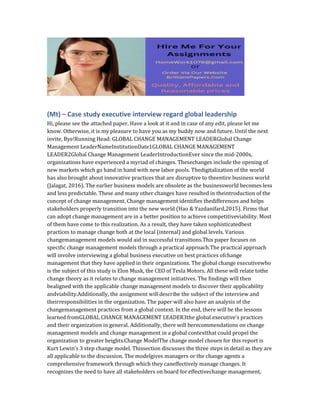
Case study executive interview regard global leadership.docx
- 1. (Mt) – Case study executive interview regard global leadership Hi, please see the attached paper. Have a look at it and in case of any edit, please let me know. Otherwise, it is my pleasure to have you as my buddy now and future. Until the next invite, Bye!Running Head: GLOBAL CHANGE MANAGEMENT LEADERGlobal Change Management LeaderNameInstitutionDate1GLOBAL CHANGE MANAGEMENT LEADER2Global Change Management LeaderIntroductionEver since the mid-2000s, organizations have experienced a myriad of changes. Thesechanges include the opening of new markets which go hand in hand with new labor pools. Thedigitalization of the world has also brought about innovative practices that are disruptive to theentire business world (Jalagat, 2016). The earlier business models are obsolete as the businessworld becomes less and less predictable. These and many other changes have resulted in theintroduction of the concept of change management. Change management identifies thedifferences and helps stakeholders properly transition into the new world (Hao & Yazdanifard,2015). Firms that can adopt change management are in a better position to achieve competitiveviability. Most of them have come to this realization. As a result, they have taken sophisticatedbest practices to manage change both at the local (internal) and global levels. Various changemanagement models would aid in successful transitions.This paper focuses on specific change management models through a practical approach.The practical approach will involve interviewing a global business executive on best practices ofchange management that they have applied in their organizations. The global change executivewho is the subject of this study is Elon Musk, the CEO of Tesla Motors. All these will relate tothe change theory as it relates to change management initiatives. The findings will then bealigned with the applicable change management models to discover their applicability andviability.Additionally, the assignment will describe the subject of the interview and theirresponsibilities in the organization. The paper will also have an analysis of the changemanagement practices from a global context. In the end, there will be the lessons learned fromGLOBAL CHANGE MANAGEMENT LEADER3the global executive’s practices and their organization in general. Additionally, there will berecommendations on change management models and change management in a global contextthat could propel the organization to greater heights.Change ModelThe change model chosen for this report is Kurt Lewin’s 3 step change model. Thissection discusses the three steps in detail as they are all applicable to the discussion. The modelgives managers or the change agents a comprehensive framework through which they caneffectively manage changes. It recognizes the need to have all stakeholders on board for effectivechange management,
- 2. especially on a global scale. The three steps include; unfreezing, changeimplementation, and refreezing.At the unfreezing stage, the managers recognize that there has been a specific structurein place for a long duration of time (Dijesh & Roseline, 2017). The fabric in question shouldalready be unprofitable for the company. Alternatively, the management should have identifiedbetter structures to drive the growth of the company. For instance, the organization as a wholecould be moving in the right direction. However, there may be people or processes which are nolonger useful but are still part of the organization. In such a case, the practices must geteliminated, lest they contribute adversely to the company’s progress. Unfreezing now means thatthe managers encourage or drive employees to become aware of their daily activities. After theyare knowledgeable and gain perspective of the same, they can then unlearn the bad habitsidentified. They may begin to open up to other possibilities that could enhance the achievementof objectives (Cummings et al., 2016). In short, unfreezing is a reassessment of practices andprocesses to set in motion the wheels that promote change. It is important to note that it is duringthis stage that managers identify any restraining forces towards the change.GLOBAL CHANGE MANAGEMENT LEADER4The second stage is the change implementation itself. Since now, the employees haveopened up their minds to the wheels of change. It is time to begin the implementation process.The implementation process is usually a transitive stage and process (Dijesh & Roseline, 2017).People have to learn new tasks and take over new responsibilities. T…